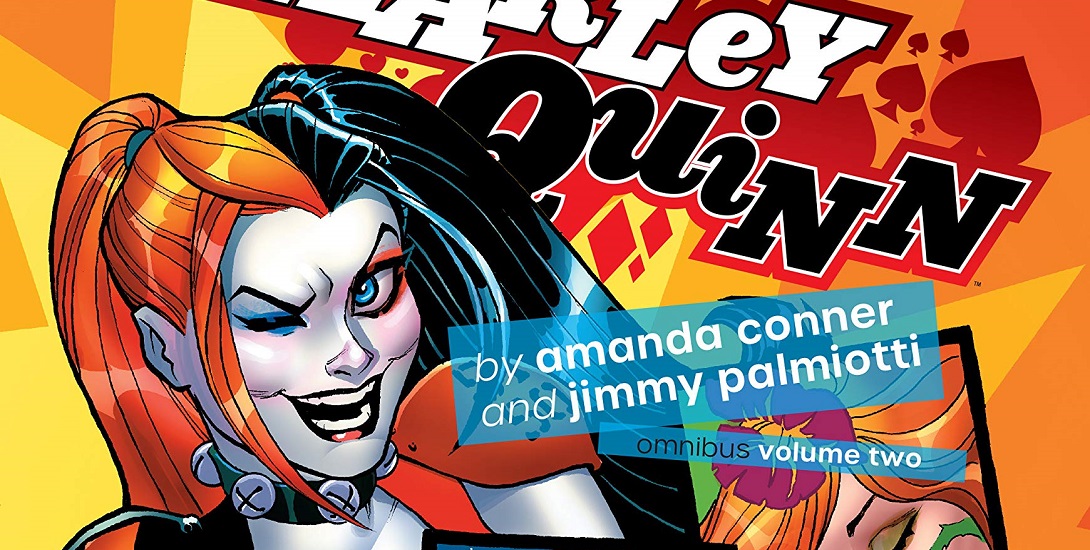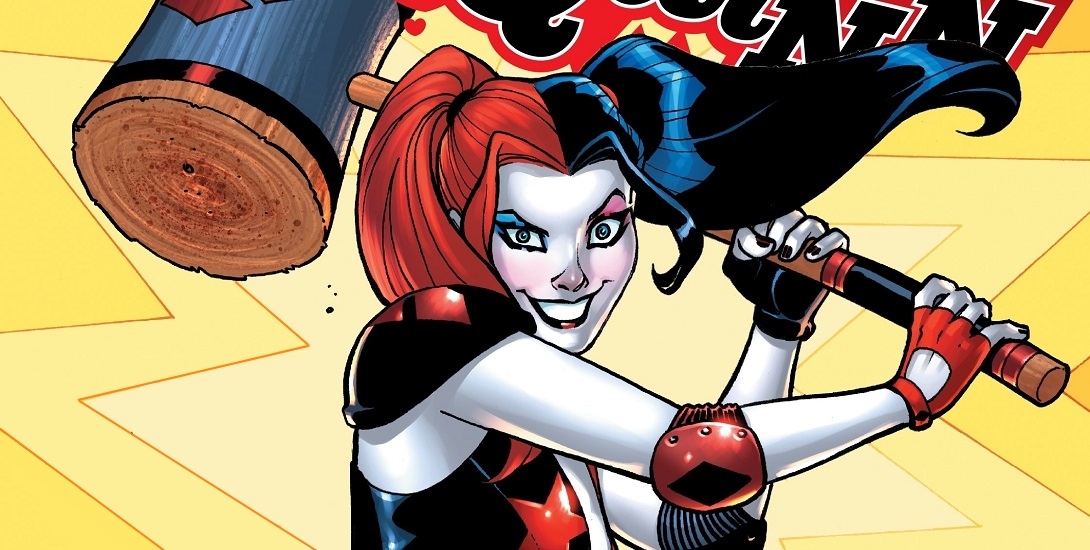Amanda Conner is an American comics artist who began her career in the late 1980s for Archie and Marvel, before moving on to DC Comics. Her work over the last 20 years includes Mad Magazine, and she recently completed an acclaimed run on Harley Quinn with her husband, Jimmy Palmiotti.
Jimmy Palmiotti is a former editor for Marvel and a successful comics writer and inker. He has written for DC and Marvel, and even co-created the popular characters Ash and Painkiller Jane for independent comics publisher Event Comics. He is also podcaster and a screenwriter for TV and film.
I was fortunate enough to chat with these amazing talents and attend their panels this past weekend, at the MCM London Comic Con. They are two of the nicest, most approachable and easy to talk to comics creators I have ever encountered.

Early memories
Amanda Conner: I’ve had comics in my life for as long as I can remember. My dad was really into them, and he wanted to be a comic-book artist when he was young. Back in the 1950s when you announced to your parents when you were young that you wanted to be a comic artist, they talked you out of it. That’s what my Nanny Nan and Grandpa did, they talked him out of it. So he went into advertising.
I think the memory of my first comic is when one of my baby teeth fell out, and I stuffed the tooth under my pillow. The tooth fairy left me a Mad Magazine and a nickel! So, that’s my first memory of an actual issue of a comic book. I remember that, every time I got sick, or that I had to stay home from school, my mom would be like, “I don’t wanna deal with this, so let me get a stack of comics, and keep her quiet.” So, I’ve always had comics… they’ve just always been around in my family.
Jimmy Palmiotti: When I was a kid, watching the Batman TV show, and then going out and buying my first Batman Halloween costume, was pretty much it. The plastic mask was hard, and it would kinda smell after ten minutes… it was horrible. It wasn’t comic-books until I actually discovered my older brother’s comics, and then I found Batman comics. It was definitely the TV show that got me sold on Batman.
Breaking into the business
Amanda Conner: I went to the Joe Kubert school in New Jersey, in the Tri-State area. It worked out well because I didn’t have to travel very far – I lived in Connecticut at the time – the Kubert School was only an hour and a half away, so on holidays I could come home pretty easily. I didn’t have to travel from, like California or anything like that. So, that was my professional comics training.
I think a huge chunk of my training though, just came from watching my mom and dad. every once in a while my dad would create a job for himself where he would have to draw in a comic style. I would just watch him do that. My mom was always painting, always illustrating, and I would watch her all the time.
It helped to have art supplies always all over the house. I clearly remember my dad my dad marching into my room and going, “Where are all my markers?!” I was always making off with his art supplies, and he could never find them. I think that was the beginning of my formal training… that was watching my parents. Or, maybe that’s informal training? It helped, just hanging out and watching them all the time.
It took me a while to actually get my foot in the door (of the comics business). I went back and forth from Marvel and DC, I think maybe five or six times, before I got my first job.

Amanda Conner: I was also working as an assistant to Bill Sienkiewicz at the time, so that was… interesting. Basically I was just picking up after him.
Bill’s incredible! He’s all about the process; once the art is finished, he just no longer cares. He was (working on) Elektra Assassin at the time, and I got to model a little bit for him too. The previous Halloween I’d dressed up as Elektra, and I had photos. So he’s like, “You wanna like, do poses for me?” I’m like, “Yeah!” So, if you look at Elektra Assassin issues 1 through 4, she looks like this tall, formidable Greek girl, with long black hair. By the end it’s just me in a red bandana going, “Hi!” and it doesn’t even look like Elektra anymore.
I remember walking into his studio one morning. There was a beautiful Elektra Assassin page on the easel which was almost done, and then there was a finished one on the floor with a sneaker-print on it! Once he’d finished he no longer cared.
So, he was saying “Go into Marvel and DC, they’re letting everybody in now” and I’m like, “OK, cool!” My first job was Solo Avengers #12. I got to do a Yellowjacket story, and this was the female Yellowjacket from the late ’80s. I was so lucky; I got Stan Drake to ink over (my pencils) and I think that’s the reason I got more work. Everybody thought, “Hey! She draws like Stan Drake!” Yeah, that was my foot in the door job, and it was great.
Pluses and minuses of writing
Amanda Conner: I have writing days and I have drawing days, I can’t really overlap them easily. I have to get my brain into a different “Head-set.” When I was drawing and writing, when we we working on the Before Watchmen books, I would lay out the page and do writing notes in the sides of the layouts, so I could remember, “Alright, this is what I want it to be.” I would actually write while I was drawing, and I’d add a little bit of dialogue around the margins. So if I’m writing and drawing, it’s completely different for me, than if I’m just writing, or just drawing.
It’s hard for me to write, I’m so used to drawing. Writing is difficult for me. All of us are night owls, none of us sleep. I think that’s the bane of being an artist. My brain just, you know, the wheels get greased at around 10pm, and I just go really well. My best hours are 10pm to 2am. When you work from home people think you’re not working, so you’re like, “No, I can’t do that right now… I have to finish, I have a deadline.” So… it’s difficult to try and tell people, “No, no, I gotta really work.”
Yeah, night owls. It’s funny, because when Jimmy was inking he used to be a night owl, but now that he’s a writer he gets up really early. I think your brain just goes a different way. My dad used to be a night owl and my mom was an early bird. Now that they’re retired, they both just stay in bed and read the paper.

Jimmy Palmiotti: It’s great writing a hero from a villain’s, or an anti-hero’s perspective. The idea of putting Batman in Harley Quinn and seeing him from Harley’s perspective is that he’s a pain in the @$$. He gets in the way, he ruins her fun… but, at the same time, she’s really curious about him.
Whenever he appeared in Harley’s book we always poked fun at Batman. Recently I had him hanging upside down, about to die, in a vat of boiling oil, and somebody says, “Batman, do you need any help?” and he’s all “No, no… I’ll get out of this. You go do your thing, I’ll be fine.”
I’ve always tried to perfect the trying to step outside of Batman. I recently wrote a two part story for one of the Walmart books, where I actually retold the origin. It’s actually just Frank (Miller)’s (Batman: Year One)… that’s all I looked at, and I just added one little, tiny thing in it. “So I’m gonna make my mark over here.”
The character’s just a great character. I could’t write Batman in a Harley book exactly like when you write a Batman book. You hear his voice, and in Harley’s you hear her voice, and it’s usually like 35 voices going on at once. There’s a lot of insanity, and it’s always fun when the two of them meet. It’s definitely a lot different.
Batman: Year One is the one I read all the time. When I first saw the writing I thought, “This is how it’s done.” It has every impactful moment, it’s emotional, every character has their own tragedy going on. That book, for me, is the one that taught me how to be a better writer. That’s the book I always go back to.
I’ve only ever written the Joker being abused by Harley. It might be kind of fun to write him from a different perspective.
Advice for aspiring comics creators
Amanda Conner: I don’t know what to tell you if you want to be an illustrator, but if you want to be a comic artist learn the storytelling and learn how to (draw) interiors. A lot of people come up and they want to show me drawings, and I see these beautiful illustrations… but I don’t always see a lot of panel storytelling, or sequential storytelling. I think there’s a need for that.
When I first got into comics I had a little bit more of an animated style, and they were telling me, “It’s a little too animated. Can you make it more ‘super-heroey?'” and I would just try and bend myself to that. Then Darwyn Cooke came along and he p!$$£d me off so much, because he had this really animated style, and he got all this work. I was like, “Seriously?!?” I love his work, but I used to do that!
They were happy with my storytelling and my style, but now… you can have a million different styles, which is great! You want to develop a confidence in your style, no matter what it is, but you also want to learn how to do sequential storytelling. That’s really important.
Be persistent. It’s really easy to get discouraged. Not as much as it used to be; back when I was a kid in school, people were like, “You wanna whaaaat?” I mean for me it was the opposite, as my parents were encouraging me to do it, where some people I knew were like, “I don’t know… you’re gonna starve. Comic-books? Really?” Don’t get discouraged, and learn sequential storytelling.
There you go, folks. I hope that you enjoyed this conversation with Amanda Conner and Jimmy Palmiotti, and the two part interview with John Romita Jr. from the same event. Please let us know your thoughts, and look out for upcoming chats with Tim Sale, a round table with some of DC Comics’ finest artists and an in-depth conversation with the legendary Frank Miller.


